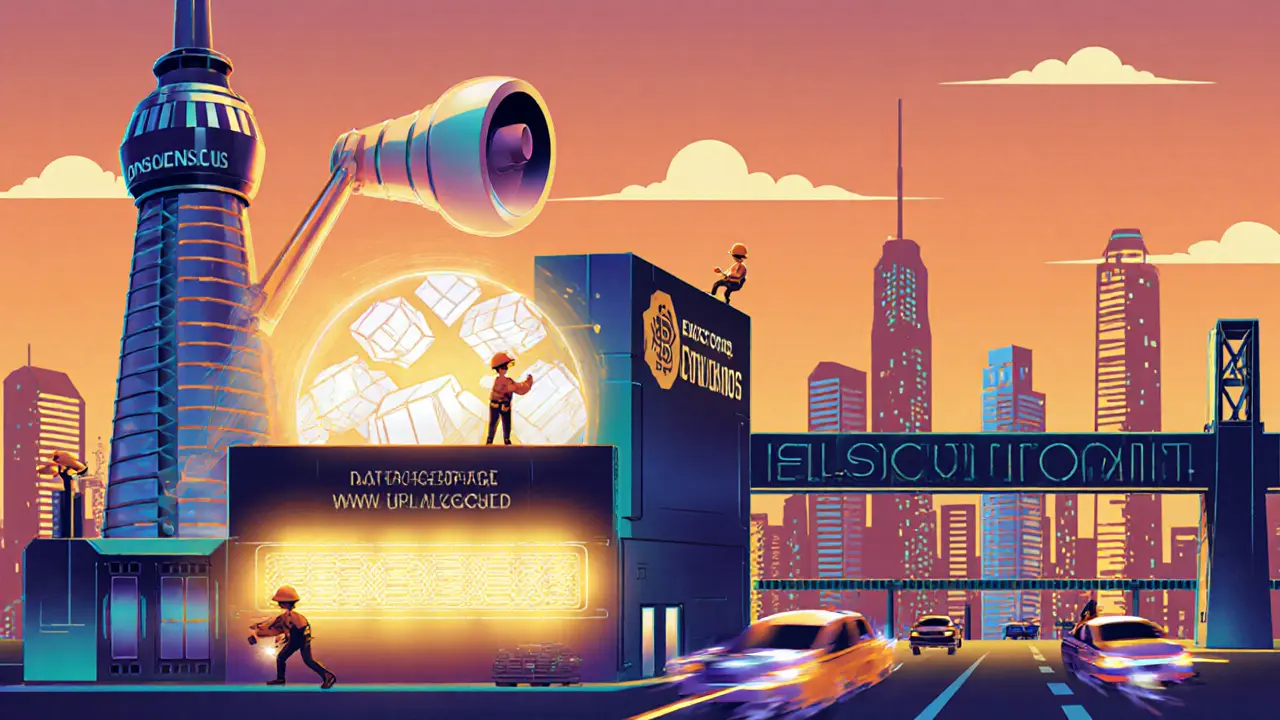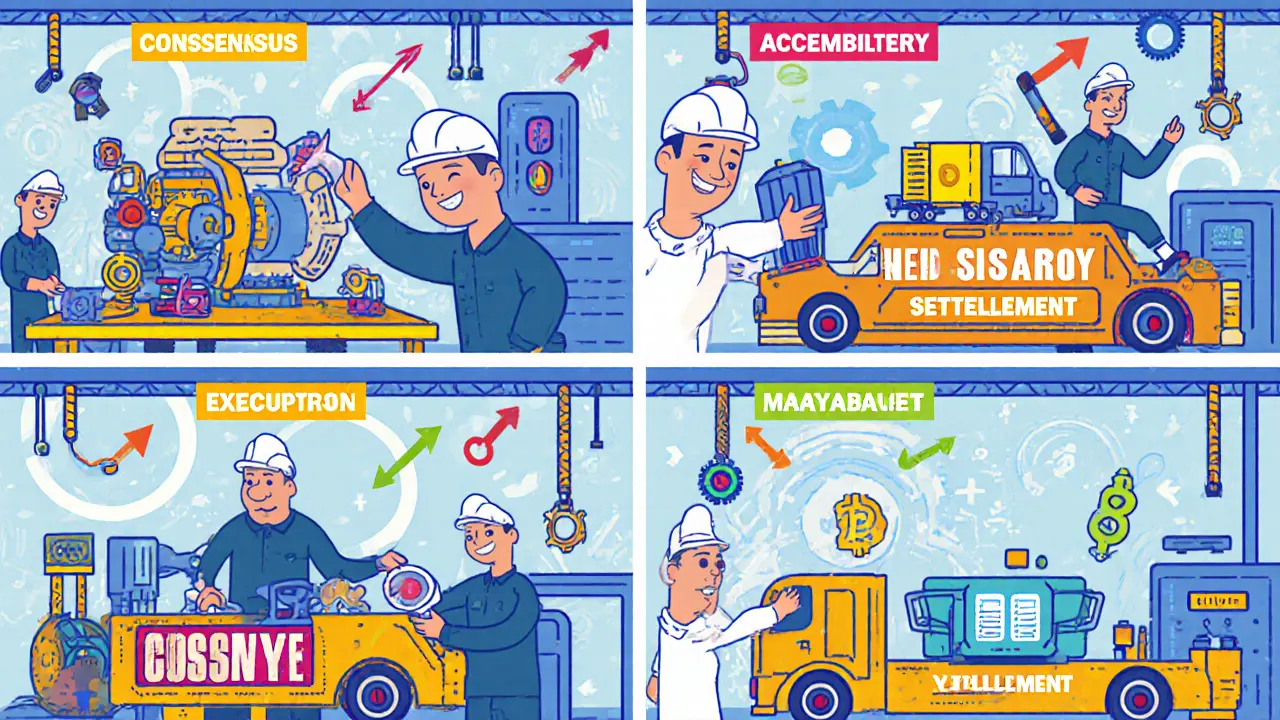Modular vs Monolithic Blockchain Comparison Tool
Compare Blockchain Architectures
Recommended Architecture
| Feature | Modular Design | Monolithic Design |
|---|---|---|
| Max Scalable TPS | ||
| Cost Efficiency | ||
| Security Model |
Why This Recommendation?
Most blockchain networks struggle to scale. Bitcoin handles about 7 transactions per second. Ethereum managed 15 before its upgrades. Even newer chains rarely break 1,000 TPS without sacrificing decentralization or security. Why? Because most were built as monoliths - one giant piece of code doing everything. When traffic spikes, the whole system slows down. Fixing it means rebuilding from scratch. That’s not scalability. That’s desperation.
Modularity changes that. Instead of one bloated chain doing consensus, execution, and data availability all at once, modularity splits them into separate, specialized modules. Think of it like a factory. One team builds engines. Another assembles cars. A third handles shipping. Each can move at its own speed. If demand for engines doubles, you just add more engine builders. You don’t shut down the whole factory.
This isn’t theory. It’s happening now. Ethereum’s roadmap, called Danksharding, relies on modular design. It separates data availability from execution. Rollups handle transaction processing off-chain. The main chain only verifies them. This lets Ethereum scale to over 100,000 transactions per second without changing its core security model. Celestia does the same - it’s a standalone data availability layer that other chains plug into. It doesn’t execute transactions. It just proves data exists. That’s modularity in action.
How Modular Blockchains Work
A modular blockchain breaks down into four key components:
- Consensus layer: Decides which blocks are valid. Think of it as the referee.
- Data availability layer: Stores all transaction data so anyone can check it later.
- Execution layer: Runs smart contracts and processes transactions.
- Settlement layer: Finalizes cross-chain interactions and handles disputes.
Each layer can be upgraded independently. Need faster consensus? Swap out the consensus module. Want better privacy? Replace the execution layer with a zero-knowledge proof engine. No need to re-architect the whole chain. That’s the power of modularity.
Compare that to older chains like Bitcoin or early Ethereum. If you wanted to improve transaction speed, you had to change the entire protocol. Miners, nodes, wallets - everyone had to upgrade at once. One mistake, and the network forks. With modularity, you update one module. The rest keep running. It’s like replacing a car’s engine while the vehicle is still driving.
Why Modularity Beats Monolithic Blockchains
Monolithic blockchains try to do everything on one chain. That sounds simple, but it’s inefficient. Every node must store every transaction, validate every smart contract, and participate in consensus. That’s expensive. It limits how many nodes can join. Fewer nodes mean less decentralization. And when the chain gets busy, fees spike and speed drops.
Modular chains solve this by specialization. The consensus layer can be optimized for speed and finality. The execution layer can be tuned for complex smart contracts. The data layer can be built for low-cost storage. Each part uses the best tools for its job.
Here’s what that looks like in practice:
- Speed: Modular chains can process 10x to 100x more transactions than monolithic ones. Polygon’s zkEVM handles over 2,000 TPS. Ethereum’s rollups push past 3,000 TPS.
- Cost: Data storage on Celestia costs 90% less than on Ethereum mainnet. That makes DeFi and NFTs affordable for everyday users.
- Security: Rollups inherit Ethereum’s security. You don’t need to trust a new chain - you trust the base layer.
- Flexibility: Developers can build custom execution environments. Want a chain optimized for gaming? Use a modular stack. Need one for supply chain tracking? Swap in a different module.
Monolithic chains are like old smartphones with non-removable batteries. You wait years for a new model. Modular chains are like Android phones with replaceable parts. Upgrade the camera. Swap the processor. Keep the rest. It’s faster. Cheaper. Less risky.

Real-World Examples
Modularity isn’t just a concept - it’s powering real networks today.
Ethereum + Rollups: Ethereum itself is now a settlement and data availability layer. Optimism, Arbitrum, zkSync - they’re all execution modules. They handle the heavy lifting. Ethereum just verifies. This setup lets Ethereum scale without losing its status as the most secure blockchain.
Celestia: This chain does one thing: store data. It doesn’t run smart contracts. It doesn’t process payments. It just proves that data was published. Other chains - like Polygon zkEVM or EigenLayer - plug into Celestia for data availability. That’s modularity: one tool, one job, done perfectly.
Avail: Built by the Parity team (same people behind Polkadot), Avail is a modular data availability layer designed for any blockchain. It’s lightweight, fast, and open-source. Developers can spin up a new chain in days, not months, by using Avail for data and building their own execution layer.
Even Bitcoin is moving toward modularity. Projects like Lightning Network handle off-chain payments. Sidechains like Liquid process confidential transactions. They’re not part of Bitcoin’s core, but they connect to it. That’s modular thinking.
Challenges and Pitfalls
Modularity isn’t magic. It comes with new problems.
One big issue is interoperability. If your execution layer is on one chain and your data layer is on another, how do they talk to each other? Poorly designed bridges can create security holes. In 2023, a major rollup was hacked because its data availability layer didn’t properly verify transaction proofs. The fix took weeks.
Another problem is complexity. Developers used to build one app on one chain. Now they have to understand consensus, data availability, execution, and settlement - and how they connect. That’s a steep learning curve. Tools like the Ethereum Foundation’s modular stack documentation and the Celestia SDK help, but it’s still harder than building on a monolith.
Then there’s fragmentation. Too many modules mean too many chains. Users have to manage wallets across platforms. Liquidity gets split. That’s why projects like EigenLayer are building shared security layers - letting multiple chains use Ethereum’s security without duplicating nodes.
And don’t forget monitoring. In a monolith, you watch one system. In a modular stack, you watch five. Tools like OpenTelemetry and Grafana are becoming essential. Without them, you won’t know if a slowdown is in execution, data, or consensus.

What’s Next for Modular Blockchains
The next 18 months will be critical. By 2026, over 80% of new blockchain projects will use modular architectures, according to the Ethereum Foundation’s 2025 roadmap. Why? Because users demand speed, low fees, and security - and modularity delivers all three.
Here’s what’s coming:
- AI-assisted module design: Tools will auto-generate module boundaries based on usage patterns. No more guessing where to split code.
- Standardized interfaces: Like USB-C for blockchains. Any execution layer will plug into any data layer. Interoperability will improve dramatically.
- Modular wallets: Wallets that auto-detect which modules a dApp uses and connect seamlessly. No more switching networks manually.
- Hybrid chains: Some chains will combine modular design with lightweight consensus for IoT devices. Think modularity for smart fridges, not just DeFi.
The goal isn’t to replace monolithic chains overnight. It’s to give builders choices. Need a fast, cheap chain for memes? Use a modular stack. Building a bank-grade settlement system? Use a modular chain with strong audit trails. The right tool for the job - that’s the future.
How to Get Started
If you’re a developer, start here:
- Learn how rollups work. Read the Ethereum documentation on Optimism and zkSync.
- Deploy a simple smart contract on a modular chain like Polygon zkEVM. See how it differs from Ethereum mainnet.
- Try building a data availability layer using Celestia’s SDK. You don’t need to write a full chain - just publish some data and verify it.
- Join the Modular Blockchain Discord. Over 15,000 developers share code, debug issues, and collaborate.
If you’re a user, look for dApps built on rollups. They’ll have lower fees and faster speeds. Check the chain they’re on - if it’s built on Ethereum or Celestia, it’s modular. That means better security and room to grow.
Modularity isn’t about making blockchains bigger. It’s about making them smarter. Instead of one slow, heavy machine, you get a network of specialized tools working together. That’s how you scale - without breaking.
What is the main advantage of modular blockchains over monolithic ones?
Modular blockchains split functions like consensus, execution, and data storage into separate layers. This lets each layer scale independently. A monolithic chain must scale everything at once, which slows it down and raises costs. Modular chains can handle 10x to 100x more transactions without sacrificing security or decentralization.
Can existing blockchains like Bitcoin become modular?
Bitcoin’s core protocol is monolithic, but it can use modular extensions. The Lightning Network handles off-chain payments. Sidechains like Liquid process confidential transactions. These aren’t part of Bitcoin’s main chain, but they connect to it. That’s modular thinking - adding specialized tools without changing the base.
Are modular blockchains more secure?
Yes - if designed well. Modular chains often inherit security from a trusted base layer, like Ethereum. Rollups, for example, use Ethereum to verify their transactions. That means they get Bitcoin-level security without needing their own miners. But poor module integration can create new attack surfaces. Security depends on how well the modules connect.
What’s the difference between modular and microservices in blockchain?
Microservices are a software pattern for apps - small, independent services talking over APIs. Modular blockchains are a network-level architecture. Each module runs at the protocol level: consensus, data, execution. It’s not about app services - it’s about how the entire blockchain is built. Think of it as changing the engine of a car, not just adding a GPS app.
Do I need to learn new programming languages to use modular blockchains?
No. Most modular chains still use Solidity for smart contracts, just like Ethereum. You don’t need to learn new languages. What changes is how you think about deployment. Instead of deploying one contract on one chain, you might deploy an execution module on a rollup and connect it to a data layer like Celestia. The tools are evolving to make that easier.
What happens if one module fails in a modular blockchain?
If a module fails - say, an execution layer goes down - the rest of the system can keep running. Users can still access data on the data layer. Consensus still works. The system doesn’t crash. You lose functionality in that one module, but the chain stays alive. That’s far more resilient than a monolithic chain where one bug can bring everything down.
